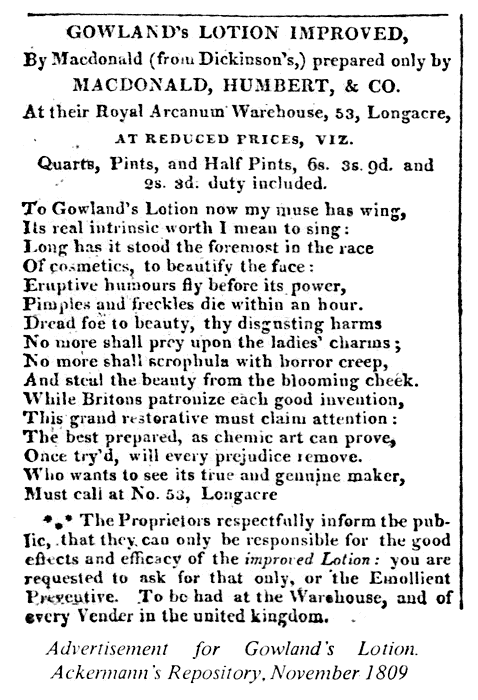Logging in to the bl0g to check in and do a little blogging, I spent the regrettable five minutes wading through the sea of spam. “Great post on cctv surveillance. Check out mine.” Huh?
“I would love to post. Please clarify what your blog is about.” Okay. No.
And as the absurdities of the spam comments struck me (does anyone actually think these are real comments?) I began thinking about spam in the Regency. What was their form of annoying junk mail or telemarketing (am I dating myself with that one?). With increasing urbanization and specialization of the work force, as industrialization and mechanization kicked into full gear (I know that’s a lot of izations!), advertising too was beginning humbly among the swaths of entrepreneurs ready to inundate the unsuspecting masses.
But, devoid of email accounts and telephones, where were Regency folk getting overloaded with commercials?
According to Francis Doherty “quack medicine” was a significant “symptom” of the development of advertising. While scholars have argued that the quack’s committment to advertising saturation indicated a business weakness, rather than strength (ie spam), it nonetheless was a pervasive reminder of a slow shift to a consumer culture.

In publications, advertisements might appear like the above, in lyrical form meant to whirl the young romantic (and literate) lady into the same consumer swoons now familiar to teen magazine readers who clutch the latest cover girl ad (or watch America’s Top Model, for that matter). But advertising would not be limited to the Ton, the fashionable set of people hungry for new ways to distinguish themselves and underline their social/economic standing.
A burgenoning working and middle class, too, would parrot the consumer ways of the upper class in purchasing which would also make advertising to these audiences a lucrative medium. Stobart’s paper highlights the fact that second hand and first class goods would be parallel in advertisements in the broadsheets during the Georgian era, coupling classes under the umbrella of consumptive practices.
http://www.sensationpress.com/victorianadvertising.htm features some wonderful examples of Victorian advertising, as the middle class began to come into full form and ready made products were now more affordable and available with mass production. By the Victorian era, nothing was too sacred for adverts, and everything from stain removers to underwear hocked with a variety of drawn pictures and witty wording. In an age where society was obsessed with cleanliness, advertising would find fertile ground in offering the sterile products we now take for granted…pimple cream, perfumes named after celebs, and insect destroying powder.
It once again reminds me that so many things we take for granted as a “sign of the times” had their birth much, much earlier–and that we could all benefit from a healthy obsession with history.
For more information, check these books I cited:
Francis Doherty, A study in eighteenth-century advertising methods: the anodyne necklace,1992
Stobart, J. (2007) In and out of fashion? Advertising novel and second-hand goods in Georgian England.












heh heh, advertising poetry parodying Pope, I like it! nothing is new under the sun, even spam. I guess I now need to look into whether such advertising appeared on broadsheets and chap books to take it even further back to the advent of printing itself – and I have to say, I wouldn’t be surprised to find it. After all, there’s spam on the walls as graffiti in Pompei and Herculaneum.